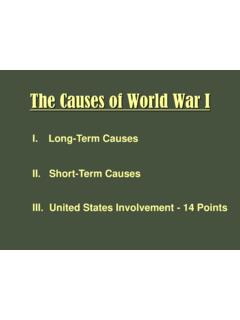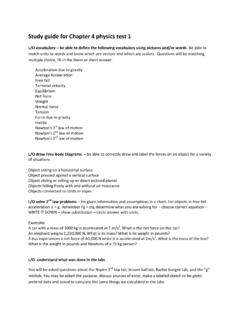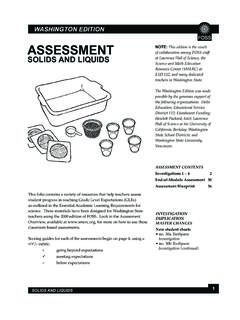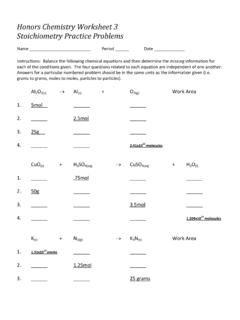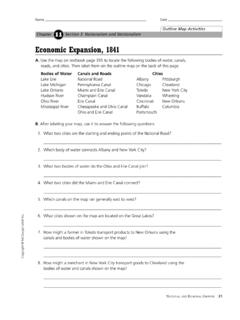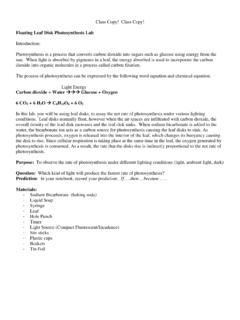Transcription of The Planting of English America, 1500 1733
1 Copyright cengage learning . All rights reserved. CHAPTER 2 The Planting of English america , 1500 1733 PART I: REVIEWING THE CHAPTER A. Checklist of learning Objectives After mastering this chapter, you should be able to: 1. Explain why England was slow to enter the colonization race and what factors finally led it to launch colonies in the early seventeenth century. 2. Describe the development of the Jamestown colony from its disastrous beginnings to its later prosperity. 3. Describe the cultural and social interaction and exchange between English settlers and Indians in Virginia and the effects of the Virginians policy of warfare and forced removal on Indians and whites. 4. Compare the tobacco-based economic development of Virginia and Maryland with South Carolina s reliance on large-plantation rice-growing and African slavery based on West Indian models. 5. Identify the major similarities and differences among the southern colonies of Virginia, Maryland, North Carolina, South Carolina, and Georgia.
2 B. Glossary To build your social science vocabulary, familiarize yourself with the following terms. 1. nationalism Fervent belief and loyalty given to the political unit of the nation-state. Indeed England now had .. a vibrant sense of nationalism and national destiny. 2. primogeniture The legal principle that the oldest son inherits all family property or land.. laws of primogeniture decreed that only eldest sons were eligible to inherit landed estates. 3. joint-stock companies An economic arrangement by which a number of investors pool their capital for investment. Joint-stock companies provided the financial means. 4. charter A legal document granted by a government to some group or agency to implement a stated purpose, and spelling out the attending rights and obligations.. the Virginia Company of London received a charter from King James I of England.. 5. census An official count of population, often also including other information about the population.
3 By 1669 an official census revealed that only about two thousand Indians remained in Virginia.. 6. feudal Concerning the hierarchical, decentralized medieval social system of personal obligations between rulers and ruled. Absentee proprietor Lord Baltimore hoped that .. Maryland .. would be the vanguard of a vast new feudal domain. 12 Chapter 2: The Planting of English america , 1500 1733 Copyright cengage learning . All rights reserved. 7. indentured servant A poor person obligated to a fixed term of unpaid labor, often in exchange for a benefit such as transportation, protection, or training. Also like Virginia, it depended for labor in its early years mainly on white indentured servants.. 8. toleration Originally, religious freedom granted by an established church to a religious minority. Maryland s new religious statute guaranteed toleration to all Christians.
4 9. squatter A frontier farmer who illegally occupied land owned by others, or land not yet officially opened for settlement. The newcomers, who frequently were squatters without legal right to the soil .. 10. buffer In politics, a small territory or state between two larger, antagonistic powers , established to minimize the possibility of conflict between them. The English crown intended Georgia to serve chiefly as a buffer. 11. melting pot Popular American term for an ethnically diverse population that is presumed to be melting toward some common homogeneous national identity. The hamlet of Savannah, like Charleston, was a melting-pot community. PART II: CHECKING YOUR PROGRESS A. True-False Where the statement is true, circle T; where it is false, circle F. 1. T F England s politics and foreign policy in the sixteenth century were primarily shaped by its religious rivalry with Catholic Spain.
5 2. T F The earliest English colonization efforts experienced surprising success. 3. T F The defeat of the Spanish Armada was important to North American colonization because it enabled England to conquer Spain s New world empire. 4. T F Two groups eager to join colonization ventures were farmers driven off their lands by enclosure and disinherited younger sons of the upper-class gentry. 5. T F Originally, the primary purpose of the joint-stock Virginia Company was to guarantee the long-term welfare of the freeborn English settlers in the colony. 6. T F The survival rate of colonists in Jamestown s first two decades was very low, less than 20 percent. 7. T F Virginia s leaders promoted a policy of peaceful assimilation of the Indians, which resulted in frequent white-Indian intermarriage. 8. T F The Maryland colony was founded to establish a religious refuge for persecuted English Quakers.
6 9. T F From the time of its founding, South Carolina had close economic ties with the British West Indies. 10. T F The slave codes, eventually adopted throughout England s North American colonies, gradually developed from the model of Virginia s indentured servitude laws. 11. T F After considerable experimentation, South Carolina s plantation owners finally found in silk a successful product that they could export. 12. T F South Carolina prospered partly by selling African slaves in the West Indies. Chapter 2: The Planting of English america , 1500 1733 13 Copyright cengage learning . All rights reserved. 13. T F Compared with its neighbors Virginia and South Carolina, North Carolina was more democratic and individualistic in social outlook. 14. T F Britain valued the Georgia colony primarily as a rich source of gold and timber. 15. T F All the southern colonies eventually came to rely on staple-crop plantation agriculture for their economic prosperity.
7 B. Multiple Choice Select the best answer and circle the corresponding letter. 1. After decades of religious turmoil, Protestantism finally gained permanent dominance in England after the succession to the throne of a. King Edward VI. b. Queen Mary I. c. Queen Elizabeth I. d. King James I. e. King Charles I. 2. England s first two North American colonies, which completely failed, were launched in a. Florida and Georgia. b. Newfoundland and North Carolina. c. Massachusetts and Maine. d. Bermuda and Barbados. e. New York and New Jersey. 3. Imperial England and English soldiers developed a contemptuous attitude toward natives partly through their earlier colonizing experiences in a. Canada. b. Spain. c. India. d. Ireland. e. the West Indies. 4. England s victory over the Spanish Armada gave it a. control of the Spanish colonies in the New world . b. naval dominance of the Atlantic Ocean and a vibrant sense of nationalism.
8 C. a stable social order and economy. d. effective control of the African slave trade. e. the power to control and colonize Ireland. 5. At the time of its first colonization efforts, England was a. struggling under the political domination of Spain. b. enjoying a period of social and economic stability. c. experiencing increasing ethnic and religious diversity. d. undergoing sharp political conflicts between advocates of republicanism and the monarchy of Elizabeth I. e. undergoing rapid and disruptive economic and social transformations. 6. Many of the early Puritan settlers of america were a. displaced sailors from Liverpool and Bath. b. merchants and shopkeepers from the Midlands. c. urban laborers from Glasgow and Edinburgh. d. displaced farmers from eastern and western England. e. dissenting clergy from Canterbury and York. 14 Chapter 2: The Planting of English america , 1500 1733 Copyright cengage learning .
9 All rights reserved. 7. England s first colony at Jamestown a. was an immediate economic success. b. was saved from failure by John Smith s leadership and by John Rolfe s introduction of tobacco. c. enjoyed the strong and continual support of King James I. d. depended on the introduction of African slave labor for its survival. e. was saved from near-starvation by generous food contributions from the Powhatan Indians. 8. Representative government was first introduced to the Americas in the colony of a. Bermuda. b. Maryland. c. North Carolina. d. Georgia. e. Virginia. 9. One important difference between the founding of the Virginia and Maryland colonies was that Virginia a. colonists were willing to come only if they could acquire their own land, while Maryland colonists were willing to work as tenants for feudal landlords. b. depended primarily on tobacco for its economy, while Maryland turned to rice cultivation.
10 C. depended on African slave labor, while Maryland relied mainly on white indentured servitude. d. was founded as a strictly economic venture, while Maryland was intended partly to secure religious freedom for persecuted Roman Catholics. e. struggled to find effective leadership for several decades, while Lord Baltimore personally governed Maryland s early colonists. 10. After the Act of Toleration in 1649, Maryland provided religious freedom for a. Jews. b. atheists. c. Baptists and Quakers. d. those who denied the divinity of Jesus. e. Protestants and Catholics. 11. The primary reason that no new English colonies were founded between 1634 and 1670 was the a. obvious economic unprofitability of Virginia and Maryland. b. civil war in England. c. continuous naval conflicts between Spain and England that disrupted sea-lanes. d. English kings increasing hostility to colonial ventures.
